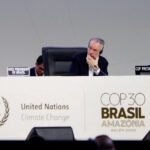The COP30 Climate Summit, held in Belém, culminated with a dual but pretty clear-cut message: climate multilateralism is still very much alive and capable of delivering agreements, although the pace of progress is still far too slow if we are to meet the goals of the Paris Agreement.

Brazil’s Presidency presented this edition as an ‘implementation COP,’ and the outcome reflects that pragmatic ambition: limited but tangible steps forward on adaptation, finance and a just transition, while the mitigation ambition gap remains unresolved. Notably, the absence of any call to phase out fossil fuels, and the fact that—even with 122 new climate plans covering 70% of global emissions—the progress being made still falls short of closing the gap, showing that the global engine is moving forward but at a pace well below what science requires.
When it comes to climate change adaptation, COP achieved a genuine milestone by securing a commitment to triple the annual financing figure to USD120 billion by 2035, accompanied by the adoption of 59 technical indicators for the Global Goal on Adaptation. Although there is still a lot on the drawing board—from governance to operational mechanisms—we are seeing increasing levels of political consensus on the need to become more resilient. In climate finance, the participating countries reaffirmed the new collective goal of mobilizing USD300 billion annually, increasing to USD1.3 trillion by 2035, but failed to define the instruments needed to achieve it. Decisions have been pushed into a two-year work program, thus prolonging uncertainty in an area that is crucial for mobilizing private capital at scale.
COP30 has genuine worth in helping to guide strategic decision-making among global banks
The global financial sector would do well to take heed of this global state of affairs. While the lack of ambition (especially on mitigation) may be seen as a form of stalemate, in actual fact COP30 has genuine worth in helping to guide strategic decision-making among global banks.
First, the summit points to the need for clearer and more stable policy signals to drive the climate investment cycles the world is calling for. The transition will not accelerate without predictable, coherent regulatory frameworks that can provide forward visibility conducive to long-term investment flows. Significant progress around the world has been made over the past decade, including rapid technological improvements, declining costs, record levels of renewable energy capacity, and heavy investment in clean energy. However, many countries’ heavy dependence on fossil fuels and the current geopolitical landscape have led to fragmented climate policies. While everyone is moving forward in the same direction (and that won’t ever stop), the current environment is creating diverging pathways and speeds, which poses a major challenge for global banks as they look to support their clients.
Second, COP consolidated country platforms as accelerators of bankable projects—a nascent trend with transformative potential in emerging markets. These platforms, led by governments but structured with active participation from both public and private stakeholders, allow for the creation of project pipelines aligned with national climate objectives. Brazil happens to be a case in point: its Brazil Investment Platform (BIP) has mobilized 15 projects totaling USD22.6 billion in just one year. Moreover, the announcement of 14 new platforms confirms that this instrument is poised to become a key channel for generating outstanding projects, lowering institutional barriers, and improving bankability through closer coordination between public policy and private finance.

Third, the decision to triple global adaptation finance makes climate change adaptation and resilience an enticing new business opportunity for financial institutions. Although much of the required investment will continue to come from the public sector, there is now growing room for private investment in resilient infrastructure, nature-based solutions, digital tools for managing physical risks, climate-smart agriculture and urban models designed to cope with extreme events. For a global bank, this means developing advanced methodologies for analyzing physical climate risks, designing resilience-oriented financial products and supporting clients in assessing vulnerabilities and opportunities that previously had limited visibility on balance sheets.
The fourth standout element is the progress made toward innovative risk-reduction mechanisms through public-private or blended-finance structures, as key tools in attracting private capital at scale in emerging markets. An interesting new feature is balance sheet optimization through new climate securitization models, as exemplified by the Inter-American Development Bank’s ReInvest+ initiative. This novel approach allows for the securitization of portfolios across sectors and countries, combined with political- and currency risk insurance provided by the IDB itself. This generates two crucial benefits: capital optimization for banks and the creation of attractive green assets for institutional investors. Such innovation could well become a key mechanism for expanding climate finance capacity without straining the balance sheets of traditional banks.
Taken together, the outcomes from Belém should not be viewed as a sign of multilateral paralysis. In fact, thanks to the Paris Agreement framework, the world has moved from projections above 4°C to an estimated range of 2.3–2.5°C today, assuming full implementation of the newly announced nationally determined contributions (NDCs).
Once again, COP30 has revealed that global governance is not enough. Distributed action, at both national and sector-level, is also essential, where leading companies and global financial institutions have a central role to play as investment catalysts and active agents of transformation.